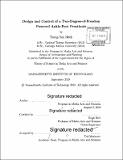Design and control of a Two-Degree-of-Freedom powered ankle-foot prosthesis
Author(s)
Hsieh, Tsung-Han(Sensing technology scientist)
Download1145278302-MIT.pdf (14.35Mb)
Other Contributors
Program in Media Arts and Sciences (Massachusetts Institute of Technology)
Advisor
Hugh Herr.
Terms of use
Metadata
Show full item recordAbstract
Powered ankle prostheses have been proven to improve the walking economy of transtibial amputees although these powered systems are usually much heavier in weight than conventional prostheses. All commercial powered ankle prostheses that are currently available can only perform one-degree-of-freedom motion in a limited range. However, the human ankle can perform both frontal and sagittal plane motions. Studies have shown that the frontal plane motion during ambulation is associated with balancing. As more advanced neural interfaces have become available for amputees, it is possible to fully recover ankle function by combining neural signals and a robotic ankle. Accordingly, there is a need for a powered ankle prosthesis that can have active control on not only plantarflexion and dorsiflexion but also eversion and inversion. The objective of this thesis is to design and evaluate a two-degree-of-freedom powered ankle-foot prosthesis that is untethered and can support an average size human for level-ground walking with full power. At present, a system with such capabilities only exists as tethered. The prosthesis presented in this thesis is a second-iteration design based on its predecessor. The new design features a larger joint range of motion, a more robust transmission, and a more powerful battery module. Benchtop tests and walking trials were conducted to evaluate the system. The results demonstrate system characteristics and dynamics and the ability to support body weight in level-ground walking.
Description
Thesis: S.M., Massachusetts Institute of Technology, School of Architecture and Planning, Program in Media Arts and Sciences, 2019 Cataloged from PDF version of thesis. Includes bibliographical references (pages 99-102).
Date issued
2019Department
Program in Media Arts and Sciences (Massachusetts Institute of Technology)Publisher
Massachusetts Institute of Technology
Keywords
Program in Media Arts and Sciences